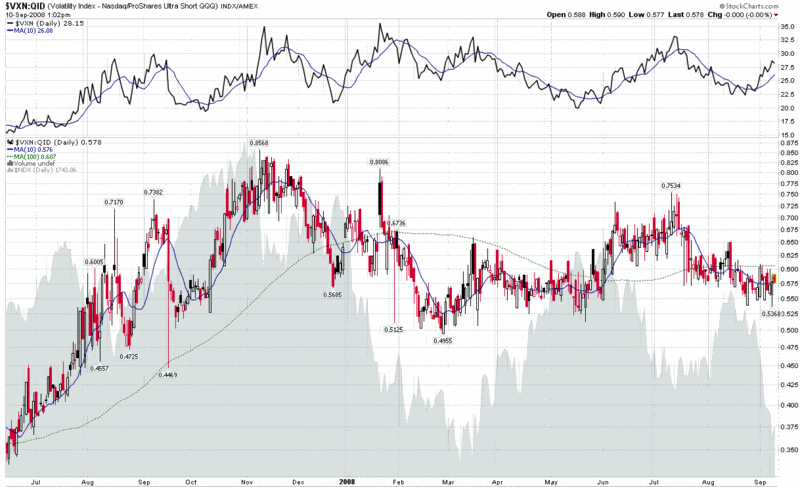VXN:QID Ratio Reflects Unusual Complacency
With the Fannie/Freddie bailout getting no better than mixed reviews, the U.K., Germany, and Spain apparently headed for a recession, and continuing turmoil in emerging markets, sometimes I am surprised to see any green at all on my screen.
On the other hand, I’m sure some are wondering how close we can be to a collapse in the world’s financial system if the VIX is trading in the 24s.
It’s a valid question – and one I have addressed in the past on the blog with the benefit of several indicators which help evaluate how much complacency is in the market. One of these is a ‘fearogram,’ which measures the ratio of changes in the VIX to changes in the SPX. A similar tool is the VIX:SDS ratio, which compares the relative movements of the VIX and SDS (the double inverse ETF for the SPX) to historical patterns.
Below I have created a chart of the VXN:QID ratio, a sister to the VIX:SDS ratio. This chart compares volatility in the NASDAQ-100 index (NDX) to the double inverse ETF for the NDX. There are (at least) three ways to think about complacency in this chart:
- the absolute level of the ratio
- the level of the ratio relative to the 10 day simple moving average
- the level of the ratio relative to the 100 day simple moving average
Looking at the chart, consider that lower readings generally correspond to lower levels of complacency (i.e., less volatility and fear per unit of decline). The current ratio is moderately low on an absolute scale, but is lodged neatly between the 10 and 100 day SMAs. What I find particularly interesting about the chart is that in those instances in which the VXN has experienced a sustained rise over a period of several weeks or more (see top section of graphic), the current situation is the first time the ratio has not risen on par with the VXN. This development is a divergence worth watching and one which appears to favor the bears.

[source: StockCharts, VIX and More]
Thanks to all who responded to my call for help about creating blog posts in Word and publishing them to Blogger. For the record, this is my first post using Windows Live Writer, which has been up to the task so far...


3 comments:
I would be careful comparing the Nasdaq Composite volatility to the Nasdaq-100 volatility. Based on this chart:
http://stockcharts.com/h-sc/ui?s=$NDX:$COMPQ&p=D&yr=3&mn=0&dy=0&id=p94076655813
I would believe the Nasdaq-100 is set to outperform the Nasdaq Composite over the near term. Assuming high levels of "fear" predict future positive performance, we would expect more fear in the Nasdaq-100 then the Nasdaq composite, and thus, your divergence.
One possible approach to the current situation is a long Nasdaq-100 short Nasdaq composite trade.
Hi Alex,
I hear you about the two NASDAQ indices and their differences. The VXN, however, is not a measure of the volatility of the NASDAQ composite index, but of the NASDAQ-100 index.
Because it can get confusing at times, I have a summary chart (and post) of the major U.S. volatility indices at Overview of the U.S. Volatility Indices
Cheers,
-Bill
Hi Bill,
I can't find the original message, unfornately.
"Marty Chenard made an interesting observation about the VIX, and it is available at his Stocktiming website--free stuff. His observation is that if there is institutional selling, then the VIX will not face upward pressure.
A simple, but rather elegant statement. So VIX is not just about fear per se, but rather when it acts in seeming incongruence to our expectations (conditions are yucky, but the VIX does not budge), then one explanation is that there is distribution in the market. And...if there is distribution, you are unwinding your position. Unwinding positions do not requiring put hedging."
You find this text here: http://theperplexedinvestor.blogspot.com/
Thanks for updating your blog with all kinds of interesting!
Peter.
Post a Comment